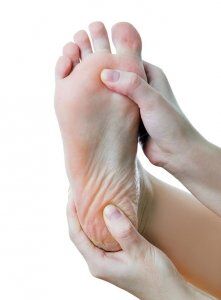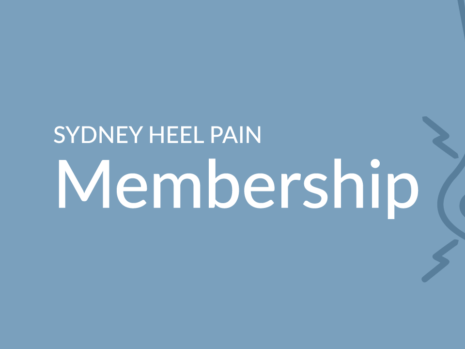Heel Pad Pain
What are the signs of heel pad pain?
Heel pad pain is most commonly felt directly in the middle of the heel bone. It is usually described as a deep and dull aching that feels like a permanent bruise. Walking barefoot on hard surfaces, such as concrete or tiles makes the pain worse.
Heel pad pain is a pain that occurs in the middle of the heel at the base of the foot. In this area of the foot, there is a fat pad called the ‘corpus adiposum’. It’s purpose is to function as a shock absorber and protect the heel bone (calcaneus) and the foot arch from impact injury. This fat pad is dense and thick, making it just perfect for its function. Over a period of time, the fat pad can atrophy (shrink) and become thin and worn all over, or in particular places, or it may become inflamed and painful. This type of heel paid pain is known as heel pad syndrome.

What causes heel pad pain?
Heel pad syndrome, and consequently heel pad pain, develops as a result of overuse, injury, atrophy, or strain. Some of the most common causes are:
- Inflammation of the fat pad
When the heel pad is placed under repeated forceful activity for prolonged periods of time, inflammation can occur. Commonly, this occurs with activities such as gymnastics, basketball or volleyball, where lots of jumping is required.
- Thinning or displacement of the fat pad
The heel fat pad may become displaced or thinned. This occurs more commonly in the elderly, as the aging process leads to some natural loss in elasticity. The heel pad pain feels like bruising, and is a result of the exposed heel bone bearing force.
- Overweight and obesity
Carrying excess body weight puts undue pressure and extra stress on the heel fat pad, which may lead to it deteriorating more quickly.
- Walking on hard surfaces (force)
When walking or running barefoot, the force that has to be absorbed by the heel is most extreme. This is especially true when walking or running on hard surfaces. This type of pressure placed on the heel can quickly lead to thinning and straining of the heel fat pad, or bruising of the heel bone.
When the plantar fascia ligament becomes inflamed or even begins to degenerate, it has a reduced ability to absorb and distribute impact in the foot from walking or running. In this case, the heel fat pad may become strained, worn or injured much more quickly than it would otherwise.
- Improper gait (manner of walking)
Having overpronated or underpronated feet (feet which lean inwards or outwards, respectively) can cause heel pad pain, because with walking or running, the heel strikes the ground in a suboptimal way. This can lead to the heel fat pad thinning or becoming inflamed in the particular areas where it strikes the ground most forcefully.
- Fat pad atrophy due to medical conditions
There are some medical conditions that may contribute to the shrinking of the heel fat paid, causing heel pad pain. These include type 2 diabetes, lupus, and rheumatoid arthritis.
Heel spurs can contribute to heel pad pain by physically digging into the heel fat pad.
The health of the foot arch and gait are the two biggest factors in contributing to heel pad pain. During walking, the feet absorb the impact of approximately two times the weight of the person’s body. When running or jumping, this force is even greater. The way the heel strikes the ground surface as a person moves will generally determine where the heel pad will wear down most quickly. Likewise, the arch of the foot functions to prop the foot up correctly, and if that arch is strained or injured (such as what happens with plantar fasciitis), this puts extra pressure on the heel pad.
How is heel pad pain diagnosed?
Being an expert in diagnosing the cause of heel pad pain, your sports podiatrist will be able to differentiate the condition from plantar fasciitis, which is the main differential diagnosis with this type of pain. In a patient with heel pad syndrome, the heel pain is typically most concentrated in the middle of the base of the heel, and tender all over the heel. In comparison, if the problem is plantar fasciitis, the patient will likely be experiencing pain in the part of the heel that is closest towards the toes (ie where the plantar fascia attaches at the heel).
Heel Pad Syndrome vs Plantar Fasciitis
Heel pad syndrome
Characteristic signs of heel pad syndrome include:
- Pain feels like a bruise and is close to the centre of the heel
- Pain is worse when walking on hard surfaces such as concrete or tiles
- Pain is worse when walking barefoot
- Pain can be recreated by pressing a finger into the middle of the heel.
Heel pad pain is caused by the wearing down or damage to the heel fat pad.
Plantar fasciitis
Characteristic signs of plantar fasciitis include:
- Pain in the heel, closest to the edge of the heel (toward the toes) and in the foot instep
- Pain may be sharp or dull and achy, and usually worse in the morning
- Pain generally improves with rest and appropriate stretching.
Pain is caused by damage and sometimes deterioration of the plantar fascia ligament, located in the arch of the foot, joining the heel and the ball of the foot.
A healthy foot arch is able to absorb the impact and distribute the force of physical activities adequately through the foot, however a flat or injured arch can ultimately lead to heel pad syndrome due to the added pressure at the heel. Sometimes heel spurs may develop, which also contribute to the development of heel pad syndrome and causing heel pad pain, as they physically dig into the fat pad, causing pain.
How is heel pad pain treated?
The aim of treating heel pad pain is to reduce the pain and inflammation itself, as unfortunately there is no cure for heel fat pad syndrome. Your sports podiatrist may suggest one or more of the following treatments:
- Rest: if you can, stay off your feet completely, or avoid doing activities cause heel pad pain or make it worse
- NSAIDs: over-the-counter non-steroidal anti-inflammatory drugs such as ibuprofen can be effective in reducing inflammation and reducing pain
- Ice: applying a covered ice pack to the sore heel for up 20 minutes at a time, at regular intervals throughout the day or immediately after activities that make the heel pad pain worse, can reduce inflammation and relieve pain
- Taping: sports tape may be used to hold the heel pad in place and provide more ‘cushioning’ or protection for the heel bone
- Heel pads, cups or orthoses: there are different types of implements that may be recommended by your sports podiatrist to either hold the fat pad in place, provide extra cushioning (usually foam or gel) for the heel, or to stabilize the bones of the foot and contain the fat pad
- Stretching and strengthening: your sports podiatrist may recommend particular exercises that are appropriate for your condition to improve flexibility and strength in areas where it is required.
Please be advised that the information provided in this article should not be taken as general advice and is for educational purposes only. If you are suffering with heel pad pain, then you should consult with a qualified sports podiatrist to discuss your concerns. Appointments can be made online at sydneyheelpain.com.au or by calling 02 93883322.
Written by Karl Lockett, Sports Podiatrist


